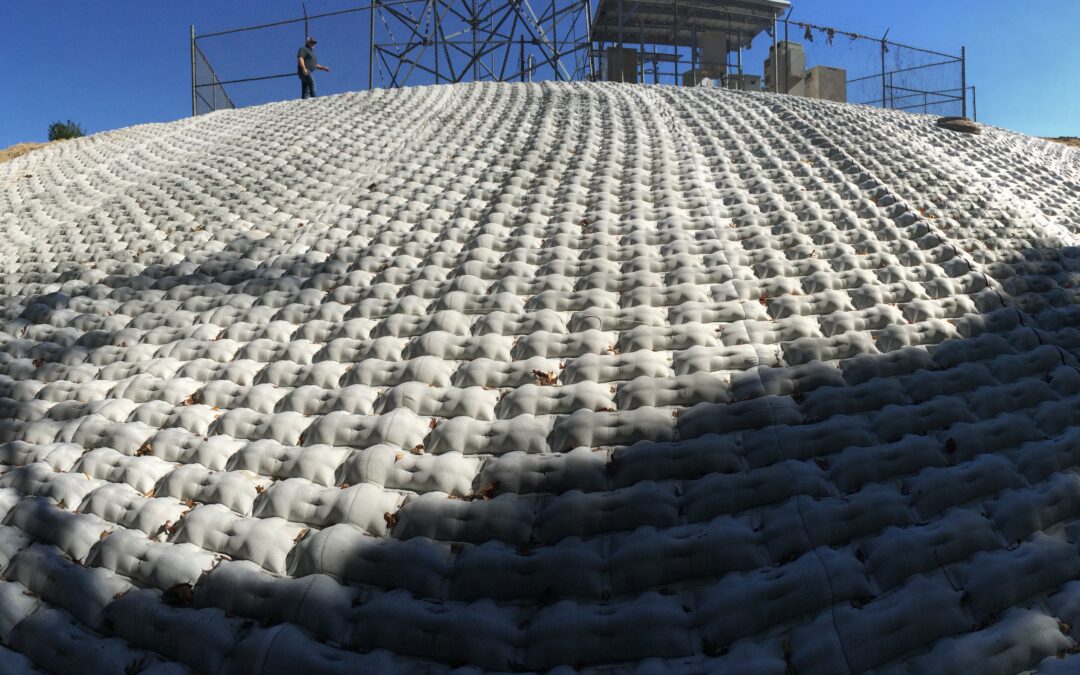
Fabric Formed Concrete for Erosion Control: How It Works and When to Use It
Erosion is one of the most persistent challenges in construction and infrastructure maintenance. Whether it’s caused by water, wind, or gravity, it threatens the stability of slopes, waterways, and industrial sites.
Traditional erosion control solutions like riprap or poured-in-place concrete can be effective, but they often come with either high costs, more site disturbance, or limitations of some sort. That’s where fabric formed concrete (FFC) can be a more efficient and durable solution.
Read on to learn more about fabric formed concrete, how it’s installed, and why it’s become a preferred method of erosion control in many environments.
What Is Fabric Formed Concrete?
Fabric formed concrete is a specialized construction method that uses high-strength geotextile fabric forms filled with pumped concrete to create durable, site-specific erosion control structures. Instead of rigid molds, the fabric itself acts as the formwork so that it can adapt to the natural contours of the terrain.
This flexibility makes FFC particularly effective for erosion-prone areas like waterways, shorelines, embankments, spillways, and industrial sites where soil stabilization is critical. The resulting concrete structures are strong, durable, and tailored to the environment they’re placed in.
How to Install Fabric Formed Concrete
Fabric formed concrete installation is straightforward, but also adaptable to the uniqueness of each environment. These are the most common steps.
- Preparation of the Site: Clear and grade the erosion-prone area as necessary.
- Placement of Fabric Forms: Lay out geosynthetic fabric panels and anchor them into position. You can customize them in thickness and shape depending on your project needs.
- Concrete Pumping: Pump concrete into the fabric until it expands to create the desired profile. The permeable fabric will allow excess water and air to escape to prevent voids and weak spots.
- Finishing and Curing: Once filled, the fabric will hold the concrete in place until it cures, forming a protective structure that conforms to the existing landscape.
Because the formwork itself is lightweight and easy to transport, installation requires less heavy equipment and labor compared to traditional methods. This is an additional reason why FFC is especially efficient for challenging environments.
Material Components of Fabric Formed Concrete
The success of fabric formed concrete lies in its simple yet effective material design, combining geotextile fabric and concrete mix.
- Geotextile Fabric: A durable, permeable textile that acts as both the mold and filter, controlling the shape of the final concrete structure while allowing water and air to escape.
- Concrete Mix: Typically a high-strength, flowable mix that can be pumped into the forms and cured to create long-lasting erosion protection.
Together, these materials form a system that adapts to site conditions while providing the strength and longevity of concrete.
Why Fabric Formed Concrete Is Ideal for Erosion Control
Fabric formed concrete offers several advantages over conventional erosion control methods.
1. Custom Shaping to Terrain
Unlike precast blocks or poured slabs, FFC molds to the contours of the land. This adaptability makes it ideal for irregular surfaces, slopes, and waterways where erosion risk is high.
2. Reduced Site Disturbance
Because the fabric is lightweight and easy to install, it requires minimal excavation and heavy equipment. This reduces environmental impact and makes it possible to stabilize areas that are otherwise difficult to access.
3. Cost-efficiency
With less material handling, labor, and equipment needed, FFC can be a more economical choice than riprap or cast-in-place concrete.
4. Strength and Durability
The combination of reinforced geotextile forms and high-strength concrete creates a system that withstands harsh conditions, including heavy water flow, freeze-thaw cycles, and chemical exposure.
5. Versatility
From protecting shorelines and levees to stabilizing industrial containment areas, FFC is suitable for many different applications (the most popular listed below).
When to Use Fabric Formed Concrete
Fabric formed concrete is best suited for projects where erosion control needs to balance durability, cost, and minimal site disruption. Some of the most common applications are:
- Waterways and canals, to prevent soil loss and bank undercutting.
- Shorelines and levees, to protect against wave action and flooding.
- Industrial sites, to stabilize containment areas, spillways, and drainage channels.
- Slopes and embankments, to reduce surface erosion and increase slope stability.
In each case, FFC provides a tailored solution that adapts to the site’s unique challenges.
Protect Your Site with Smarter Erosion Control
Fabric formed concrete combines the strength of traditional concrete with the flexibility of geotextile technology, making it one of the most practical modern solutions for erosion control. By conforming to terrain, minimizing site disruption, and delivering long-term durability, it provides environmental and economic advantages over conventional methods.
At US FUSION, we specialize in advanced erosion control systems, including fabric formed concrete installations, that protect industrial sites and critical infrastructure. If your project requires a durable and cost-effective system, our team is ready to help with our specialty product, Protex™. Contact us online to get started.





